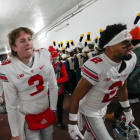
College football has always been a class war: public vs. private, Power Five vs. Group of Five, SEC vs. the world. Membership has always had its privileges. Those 65 Power Fives schools annually split 78% of the half-billion annual take from the College Football Playoff.
There is a growing thought among those power schools, which are wondering whether they should share at all. What has emerged quietly in recent months is perhaps the biggest class war in decades.
"Membership" is the buzzword as the NCAA rewrites its constitution. It would involve a further divide among the 130 schools playing major-college football. Division I-A, now called the Football Bowl Subdivision (FBS), was created in 1978. That was the last big carving of haves and have nots.
Essentially, a parting from the lowest-resourced programs in the FBS could occur. The reasons would be same as they were 43 years ago: The smallest programs have too much of an influence -- voting and otherwise -- on how a group of 80 or so schools would like big-time football to look.
"I think that discussion is going to happen," a current Power Five athletic director told CBS Sports. "In FBS, yes. The discrepancies in terms of revenue, just among FBS, is already huge. But from the Big Ten to the SEC to the smallest conferences in Division I, it's not even apples and oranges.
"For lack of a better term, we have a football problem."
The problem is that schools emphasize football on different levels. As it stands, there is little similarity between the resources (recruiting, salaries, TV contracts) of a Georgia and a Georgia Southern. Yet, they play under the same FBS banner.
"I think you'll see a stratification of it or a significant changing of it," said Virginia Tech AD Whit Babcock. "It's just a lot of work in a short period of time."
A convergence of concerns is forcing the issue. The game's power brokers must figure how to split an unprecedented forthcoming influx of money. Coffers will be fuller than ever once the College Football Playoff expands and multiple conference TV deals get renegotiated.
Many administrators believe it's inevitable that athletes -- particularly football and basketball players -- will eventually become employees of schools.
"How can the Power Five legally give more money to their athletes? [That's] what the next step is," the Power Five AD said.
A culling of the FBS herd has come into clearer focus since the NCAA decided to rewrite its constitution in August. The resulting Constitutional Convention concluded Monday with broad concepts that are expected to added at the NCAA Convention in January. The constitutional changes are expected to be fully in place by August 2022.
Implementation is another issue. The 20-person Transformation Committee to come out of that convention is responsible for addressing the details of how the NCAA steps aside and lets the divisions and conferences make their own decisions. Essentially, it will allow them to run college sports their way.
The elephant in the room in is a potential further division of the FBS. Which schools are going to make the cut, and which will be relegated to what has long been referred to as "Division IV"? While a splitting of FBS is not a certainty, it is more likely now than at any time since that last big division in 1978.
"It's not on the table yet, but that's the first thing that's going to have to asked," said West Virginia AD Shane Lyons, a member of the Transformation Committee. "With those Transformation Committee members, what are we looking for? Is it membership requirements? There is the differential between schools that make $175 million and those that make $4 million.
"One of the first questions is going to be, 'What's this going to look like?'"
Overall, rules and limits almost certainly will be liberalized. NIL has already turned what used to be major NCAA violation into shoulder shrugs.
It's the minutiae that drives Power Five ADs crazy. They are frustrated that smaller schools have such a voting influence on issues such as staff size.
"Coaching limits … I've gotten to the point where I don't care," Lyons said. "If you want eight coaches in baseball, hire eight coaches. That's between the coach, AD and president. We [worry about it] all the time in football. We pay thousands of dollars to compliance staffs to try to figure out what these people are doing on the sidelines or in practice.
"Does it really matter? Let them coach. Who cares? If Alabama wants 75 coaches, let them have 75 coaches. At West Virginia, we're going to have 20."
The Transformation Committee is co-chaired by SEC commissioner Greg Sankey and Ohio AD Julie Cromer. By its mere composition, the committee foreshadows a separation. Sankey is head of the nation's most powerful football conference. Cromer is AD of a MAC school, which plays some of its games on weeknights to maximize exposure.
SEC schools will soon be making $60 million each in average media rights fees annually. The MAC's current ESPN deal, which expires at the conclusion of the 2026-27 season, is worth $100 million … total.
"Anything that has Sankey in it would give me an indication that the divide will get greater," said a college sports consultant who spoke anonymously because of the sensitivity of the situation. "Julie being at Ohio, I really like Julie. She's smart as hell. I would see her and Sankey clashing big time. I suspect that's the case, but Greg's going to win every time because he can. He's got the power."
With the ability to flex that power comes responsibility. Any of the 130 schools that wouldn't make the cut would be losing tremendous brand power. Being in FBS allows schools to fund athletics at the highest level, increase enrollment, even attract faculty and grants.
The heartlessness of the process hit home for a couple of weeks this summer when word leaked that Texas and Oklahoma were headed to the SEC. Suddenly, there was the realization that schools such as Iowa State, Kansas State, Oklahoma State and Kansas (particularly in basketball) might only be able to call a Group of Five conference home. That fear was quickly allayed when the Big 12 took in four teams, expanded to 12 and -- it is speculated -- retained its Power Five status.
That was a signal to some that major-college football is once again going gather around a campfire of the biggest brands.
"We lost two huge brands," one Big 12 AD said. "That would be like the Big Ten losing Michigan and Ohio State. Don't take anything away, but Purdue doesn't have that big a brand. Indiana doesn't have that big a brand. If you do the analogy of an anchor, those were our two anchors. Every conference has them."
A list of options has been mentioned ranging from a 30-60 team "federation" to group of 80-100 teams that would operate by the same rules. It wouldn't so much be an exclusion of schools but a standard they must attain.
At this time, the NCAA Tournament and the 351 Division I members that add to its charm wouldn't be impacted. Schools from all three existing NCAA divisions (I, II, III) share the annual $800 million revenue from that event.
There are current minimum standards for FBS membership, including (just to name a few): sports sponsorship (16), minimum scheduling requirements (60% of games vs. FBS, 5+ home games) and average attendance (15,000). Raising the attendance minimum to 30,000 would alone theoretically cause 56 schools (43%) to lose FBS membership based on 2019 averages.
Consider top schools voting to increase their allotments to 95 football scholarships. (The current maximum is 85.) Those that couldn't afford to fund those 10 extra scholarships would be priced out of the market and possibly end up in "Division IV". Same for the idea of fully-funding equivalency sports. Those sports include baseball and soccer, which can have large rosters but split a finite number of scholarships. (For example, Division I baseball teams divide 11.7 scholarships.)
What if those minor sports were fully funded with scholarships the same as "head-count" sports such as football? It would conceivably force smaller schools to drop down a level because of the increased financial obligation.
"Can you imagine if Georgia, in that hotbed of recruiting, basically had 100 scholarships?" asked that Power Five AD.
MAC commissioner Jon Steinbrecher, whose conference might be one of those impacted by a higher cost of doing business, is not deterred.
"I'm comfortable based on conversations I've had among the FBS commissioners and with Greg Sankey," he said. "I don't think people should overreact or underreact to anything. Whatever the outcome, we're well positioned. Deregulation is really interesting to talk about in the abstract but is wicked hard to do in reality."
There has long been talk of a "breakaway" of the power schools from the NCAA itself. This isn't that. Last December, the Knight Commission recommended the FBS completely separate from the association.
With conferences having broader powers, a new constitution would provide for a true subdivision. Back in 1978, Ivy League schools had the same voting powers as Big Ten schools but didn't emphasize football in the same manner. Those Ivy League schools eventually dropped down to Division I-AA (FCS), which was able to sponsorship its own playoff. Division I-A (FBS) kept its lucrative bowl system.
When that split came, Division I-A had 137 members with 43 in Division I-AA. Today, those numbers are closer -- 130 for FBS and 125 for FCS, though there will be some adjustments coming to those totals when this round of conference realignment is completed.
Not surprisingly, J. Neils Thompson, former president of Texas, headed up a committee that recommended the split 4 ½ decades ago.
"I don't think it's excluding anyone," Lyons said of today's thinking. "It's just saying, 'Here's the criteria.' If we go down that path, here's what it's going to take to be in this certain group."
"Power Five" and "Group of Five" were terms that evolved from use by the media and college administrators around the time the Bowl Championship Series (BCS) formed in 1998. The qualification standards for those BCS bowls drew an informal line between the power conferences (ACC, Big East, Big Ten, Big 12, Pac-10, SEC) and smaller leagues (Big West, Conference USA, Mid-American, WAC).
The Power Five now consists of the ACC, Big Ten, Big 12, Pac-12 and SEC, while the Group of Five is made up of the American, Conference USA, MAC, Mountain West and Sun Belt.
Autonomy voting privileges were agreed upon for those five power conferences at the 2014 NCAA Convention. At the time, enhanced voting privileges for the Power Five set the stage for of cost of attendance stipends and NIL rights.
With the NCAA abdicating power as it restructures, the Power Five may be looking for even more weighted voting to rule Division I. For example, in the future, it is thought conferences will be on their own to create and implement enforcement procedures.
"There's some that believe, when we made the changes, we didn't go far enough with voting [in 2014], that it should be higher," Lyons said. "I think you'll have the autonomy schools and conferences push to have weighted votes."
The constitution rewrite is part of the fallout from the Alston v. NCAA decision by the U.S. Supreme Court, which stripped the NCAA of much of its power.
















